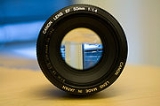
Canon EF 50mm lens
Encyclopedia
The EF 50mm lenses are a group of normal
prime
lenses
made by Canon that share the same focal length. These lenses are based on the classic double-Gauss lens, with the f/1.8 being a standard six-element double-Gauss with an air gap and powers between element 2 and 3http://www.canon.com/camera-museum/camera/lens/ef/data/standard/ef_50_18ii.html?p=2 and its faster cousins adding additional elementshttp://www.canon.com/camera-museum/camera/lens/ef/standard.html.
These lenses have an EF
type mount that fits the Canon EOS
line of cameras.
Six EF 50mm lenses have been developed and sold. Two are L series lenses
and three have Ultrasonic motor
s.
Since the 1.2L, 1.4 and 1.8 lenses can provide very similar wide-aperture shots but have very different price tags, they have naturally been the subject of many in-depth comparisons.
1.0L USM (discontinued, replaced by 1.2L)1.2L USM1.4 USM1.8 (discontinued, replaced by 1.8 II)1.8 II2.5 Compact Macro
of this lens is similar to an 80mm or 65mm on full frame camera. There will be an apparent magnification of approximately 1.6x (or 1.3x) in the final image, since the "cropped" image will fill up the sensor. This is due to the crop factor
inherent with APS-C or APS-H (crop) sensor digital SLR cameras.
An example would be taking an image of a rock using two cameras with the same lens. The first camera an 18mp full frame and the second an 18mp APS-C, both shooting the same composition in a stationary position. The first image will be more "wide" while the second image will be more "magnified". After bringing the results into an image editing program and enlarging the first image so that the rock is the same size in both images, one will see that the enlarged image is approximately 160% (1.6x) of the original. Simply put, the field of view of the APS-C will be 1.6 times smaller the original giving an appearance of magnification. (A smaller field of view
is similar to a larger zoom.)
The major advantage to this extra "reach" would be the utilizing of the full sensor space for a cropped image rather than having to crop afterwards, thus utilizing parts of the sensor that would have otherwise been wasted. The major disadvantage is the change in perspective; since the focal length has not actually changed, it will be like shooting an 80mm (APS-C) or 65mm (APS-H) shot with the perspective of a 50mm lens. The resulting image will appear to have a less pleasing background blur and unlike using a real 80mm lens for the same framing.
Current Canon full frame cameras include: EOS 5D Mark II
and EOS-1Ds Mark III
. Current Canon APS-C cameras, in ascending order of price, are the EOS 1100D
(Rebel T3), EOS 550D
(Rebel T2i), EOS 600D
(Rebel T3i), EOS 60D
and EOS 7D
. The EOS-1D Mark IV
is the only current Canon APS-H based camera.
is a professional L series autofocus lens. On the used market sells for as much as double the original retail value. It was the fastest SLR lens in production during its lifetime. This lens has a metal body and mount, and plastic extremities. It also features a wide rubber focus ring that is damped
, a distance window with infrared
index, and the ability to set the focus range from 0.6m to infinity, or 1m to infinity. In common with the EF 85mm f/1.2L USM
it uses an electronic "focus by wire" system and requires power from the camera in order to manual focus. The 8-blade diaphragm and maximum aperture
of 1.0 give this lens the ability to create extremely shallow depth of field
effects and to support low light situations. The optical construction of this lens contains 11 lens elements, including two ground and polished aspherical lens
elements. This lens uses a floating front extension focusing
system, powered by a ring-type USM motor. The front of the lens does not rotate, but does extend when focusing.
Despite its price and large maximum aperture, the 1.0L was not a particularly sharp lens at any aperture, and the two cheaper 50mm options offered far better sharpness when stopped down beyond about 2.8. This, combined with the high production cost and low sales volume, led to it being discontinued in 2000 and eventually superseded by the 1.2 edition.
is a professional L series lens designed to replace the EF 50mm 1.0L USM. It is the shortest of the two 1.2 lenses Canon makes, the other being the EF 85mm 1.2L II USM
. It is constructed with a metal body and mount, and plastic extremities. This lens features a wide rubber focusing ring that is damped, a distance window with infrared index, and is weather-sealed. A circular, 8-blade diaphragm and maximum aperture of 1.2 give this lens the ability to create very shallow depth of field effects with smooth background blur. The optical construction of this lens contains 8 lens elements, including one ground and polished aspherical lens element. This lens uses a floating front extension focusing system, powered by a ring-type USM motor. The front of the lens does not rotate or extend when focusing.
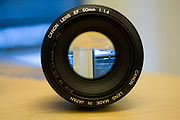 The EF 50mm 1.4 USM is a consumer- and professional-level lens. It is the least expensive 1.4 aperture lens that Canon currently manufactures. It is constructed with a plastic body and a metal mount. This lens features a distance window with infrared index. An 8-blade diaphragm and maximum aperture of 1.4 give this lens the ability to create shallow depth of field effects. The optical construction of this lens contains 7 lens elements, without any special lens elements. The lens uses a front extension focusing system, powered by a micro USM
The EF 50mm 1.4 USM is a consumer- and professional-level lens. It is the least expensive 1.4 aperture lens that Canon currently manufactures. It is constructed with a plastic body and a metal mount. This lens features a distance window with infrared index. An 8-blade diaphragm and maximum aperture of 1.4 give this lens the ability to create shallow depth of field effects. The optical construction of this lens contains 7 lens elements, without any special lens elements. The lens uses a front extension focusing system, powered by a micro USM
motor. Even though this lens uses a micro USM motor, it still has FTM (full-time manual focus) available. Auto-focus speed of this lens is fast, but not as quick as most ring-USM-based lenses. The front of the lens does not rotate, but extend up to about one centimeter when focusing.
The optical construction of this lens contains 6 lens elements, with no special elements. This lens uses a front extension focusing system, powered by an AFD motor. The front of the lens does not rotate when focusing, making it compatible with circular polarisers.
Auto-focus speed, despite the AFD motor, is moderately fast but audible.
. The optics for both lenses are identical, with 6 elements in 5 groups and a 5 blade diaphragm. The 'nifty-fifty' has a 52mm filter thread.
The 50mm focal length, when used with a 35mm film or full-frame sensor, has been widely considered to match the field of view seen by the human eye. When pairing the EF 50mm f/1.8 II to a Canon DSLR with an APS-C
sized sensor, photographers must apply a focal length multiplier (also known as a crop factor) in order to get the effective 35mm field of view equivalent. Most entry level Canon DSLRs come with a crop factor of 1.6x, which effectively turns the 50mm focal length into a 80mm field of view (50 x 1.6 = 80mm).
Because of its low price and sharp optical quality, this lens has earned the nicknames 'nifty fifty' and 'plastic fantastic'. When shooting at f/1.8, it offers a very shallow depth of field
which is beneficial for isolating subjects against a blurred background (bokeh
).
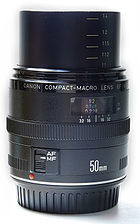 The EF 50mm f/2.5 Compact Macro is a relatively inexpensive macro
The EF 50mm f/2.5 Compact Macro is a relatively inexpensive macro
lens with a minimum focusing distance of 23cm (9 inches) offering a maximum magnification of 0.5x actual size. Reviewers describe the lens as having "decent"/"mid-level" build quality, with very good color and contrast, "absolutely negligible" distortion, very sharp after f/4 and peak performance at f/5.6. However, auto-focusing is relatively slow and noisy.
The maximum 0.5x magnification means this lens is more suitable for photographing documents, products and objects at least 5cm (2 inches) wide than small insects etc. The outer barrel is grooved to accept Canon's MR-14 ring flash
which can be used as the principal light source for close-ups or as on-axis fill lighting
for portraits. The six-blade diaphragm
provides reasonably good out-of-focus blur (bokeh
) for portrait work.
First introduced in 1987, the lens is constructed with a plastic body and metal mount, and features a distance window with infrared index and magnification markings. The optional Life-Size Converter EF adapts the lens to produce a maximum magnification of 1:1. Attaching the converter increases the lens focal length to 70mm, reduces the maximum aperture to 3.5 and limits the focal range. Magnification markings for the converter are shown on the (extending) inner lens barrel.
Normal lens
In photography and cinematography a normal lens, also called a standard lens, is a lens that reproduces perspective that generally looks "natural" to a human observer under normal viewing conditions, as compared with lenses with longer or shorter focal lengths which produce an expanded or...
prime
Prime lens
In film and photography, a prime lens is either a photographic lens whose focal length is fixed, as opposed to a zoom lens, or it is the primary lens in a combination lens system....
lenses
Photographic lens
A camera lens is an optical lens or assembly of lenses used in conjunction with a camera body and mechanism to make images of objects either on photographic film or on other media capable of storing an image chemically or electronically.While in principle a simple convex lens will suffice, in...
made by Canon that share the same focal length. These lenses are based on the classic double-Gauss lens, with the f/1.8 being a standard six-element double-Gauss with an air gap and powers between element 2 and 3http://www.canon.com/camera-museum/camera/lens/ef/data/standard/ef_50_18ii.html?p=2 and its faster cousins adding additional elementshttp://www.canon.com/camera-museum/camera/lens/ef/standard.html.
These lenses have an EF
Canon EF lens mount
Introduced in 1987, the EF lens mount is the standard lens mount on the Canon EOS family of SLR film and digital cameras. EF stands for "Electro-Focus": automatic focusing on EF lenses is handled by a dedicated electric motor built into the lens...
type mount that fits the Canon EOS
Canon EOS
The Canon EOS autofocus 35 mm film and digital SLR camera system was introduced in 1987 with the Canon EOS 650 and is still in production as Canon's current DSLR system...
line of cameras.
Six EF 50mm lenses have been developed and sold. Two are L series lenses
Canon l lens
An L lens is a line of SLR photography lenses made by Canon.L lenses are Canon's top-of-the-line lenses. The "L" officially stands for "Luxury", a reference to the lenses' high price and proclaimed build quality. The use of "ASPH" was common to notate aspherical elements throughout Canon's and...
and three have Ultrasonic motor
Ultrasonic motor
An ultrasonic motor is a type of electric motor powered by the ultrasonic vibration of a component, the stator, placedagainst another component, the rotor or slider depending on the scheme of operation...
s.
Since the 1.2L, 1.4 and 1.8 lenses can provide very similar wide-aperture shots but have very different price tags, they have naturally been the subject of many in-depth comparisons.
1.0L USM (discontinued, replaced by 1.2L)1.2L USM1.4 USM1.8 (discontinued, replaced by 1.8 II)1.8 II2.5 Compact Macro
Crop factor
When used with a Canon APS-C (1.6x crop) DSLR camera or APS-H (1.3x crop), the field of viewField of view
The field of view is the extent of the observable world that is seen at any given moment....
of this lens is similar to an 80mm or 65mm on full frame camera. There will be an apparent magnification of approximately 1.6x (or 1.3x) in the final image, since the "cropped" image will fill up the sensor. This is due to the crop factor
Crop factor
In digital photography, a crop factor is related to the ratio of the dimensions of a camera's imaging area compared to a reference format; most often, this term is applied to digital cameras, relative to 35 mm film format as a reference. In the case of digital cameras, the imaging device would be a...
inherent with APS-C or APS-H (crop) sensor digital SLR cameras.
An example would be taking an image of a rock using two cameras with the same lens. The first camera an 18mp full frame and the second an 18mp APS-C, both shooting the same composition in a stationary position. The first image will be more "wide" while the second image will be more "magnified". After bringing the results into an image editing program and enlarging the first image so that the rock is the same size in both images, one will see that the enlarged image is approximately 160% (1.6x) of the original. Simply put, the field of view of the APS-C will be 1.6 times smaller the original giving an appearance of magnification. (A smaller field of view
Field of view
The field of view is the extent of the observable world that is seen at any given moment....
is similar to a larger zoom.)
The major advantage to this extra "reach" would be the utilizing of the full sensor space for a cropped image rather than having to crop afterwards, thus utilizing parts of the sensor that would have otherwise been wasted. The major disadvantage is the change in perspective; since the focal length has not actually changed, it will be like shooting an 80mm (APS-C) or 65mm (APS-H) shot with the perspective of a 50mm lens. The resulting image will appear to have a less pleasing background blur and unlike using a real 80mm lens for the same framing.
Current Canon full frame cameras include: EOS 5D Mark II
Canon EOS 5D Mark II
The Canon EOS 5D Mark II is a 21.1-megapixel full-frame CMOS digital single-lens reflex camera made by Canon. It succeeds the EOS 5D and was announced on September 17, 2008.-Improvements compared to original EOS 5D:...
and EOS-1Ds Mark III
Canon EOS-1Ds Mark III
The EOS-1Ds Mark III is a digital SLR camera body by Canon designed for professional photographers. The Canon EOS 1Ds Mark III is successor to the EOS-1Ds Mark II and was announced in August 2007. The camera features a full-frame 21.1 megapixel CMOS sensor with 14 bit A/D converters for a total...
. Current Canon APS-C cameras, in ascending order of price, are the EOS 1100D
Canon EOS 1100D
Canon EOS 1100D is a 12.2-megapixel digital single-lens reflex camera announced by Canon on February 7, 2011. It is known as the EOS Kiss X50 in Japan and the EOS Rebel T3 in the United States and Canada. The 1100D is an entry-level DSLR that introduces movie mode to Canon's entry level DSLRs and...
(Rebel T3), EOS 550D
Canon EOS 550D
The Canon EOS 550D is an 18.0 megapixel digital single-lens reflex camera, announced by Canon on February 8, 2010. It was made available starting February 24, 2010 and to US dealers starting early March. It is known as the EOS Kiss X4 in Japan, and as the EOS Rebel T2i in North America...
(Rebel T2i), EOS 600D
Canon EOS 550D
The Canon EOS 550D is an 18.0 megapixel digital single-lens reflex camera, announced by Canon on February 8, 2010. It was made available starting February 24, 2010 and to US dealers starting early March. It is known as the EOS Kiss X4 in Japan, and as the EOS Rebel T2i in North America...
(Rebel T3i), EOS 60D
Canon EOS 60D
The Canon EOS 60D is a digital single-lens reflex camera from Canon. It is part of the Canon EOS line of cameras and succeeds the EOS 50D. It was publicly announced on August 26, 2010....
and EOS 7D
Canon EOS 7D
The Canon EOS 7D is an 18.0 effective megapixel APS-C crop CMOS digital single-lens reflex camera made by Canon. It was announced on September 1, 2009...
. The EOS-1D Mark IV
Canon EOS-1D Mark IV
The EOS-1D Mark IV is a professional 16.1 effective megapixels digital single lens reflex camera camera body produced by Canon. The EOS-1D Mark IV is the successor of the Canon EOS-1D Mark III and was announced on October 20, 2009, just four days after Nikon announced the D3s...
is the only current Canon APS-H based camera.
EF 50mm 1.0L USM
The discontinued EF 50mm 1.0L USMUltrasonic motor
An ultrasonic motor is a type of electric motor powered by the ultrasonic vibration of a component, the stator, placedagainst another component, the rotor or slider depending on the scheme of operation...
is a professional L series autofocus lens. On the used market sells for as much as double the original retail value. It was the fastest SLR lens in production during its lifetime. This lens has a metal body and mount, and plastic extremities. It also features a wide rubber focus ring that is damped
Damping
In physics, damping is any effect that tends to reduce the amplitude of oscillations in an oscillatory system, particularly the harmonic oscillator.In mechanics, friction is one such damping effect...
, a distance window with infrared
Infrared photography
In infrared photography, the film or image sensor used is sensitive to infrared light. The part of the spectrum used is referred to as near-infrared to distinguish it from far-infrared, which is the domain of thermal imaging. Wavelengths used for photography range from about 700 nm to about...
index, and the ability to set the focus range from 0.6m to infinity, or 1m to infinity. In common with the EF 85mm f/1.2L USM
Canon EF 85mm lens
The EF 85mm lenses are a group of medium telephoto prime lenses made by Canon Inc. that share the same focal length. These lenses have an EF type mount that fits the Canon EOS line of cameras....
it uses an electronic "focus by wire" system and requires power from the camera in order to manual focus. The 8-blade diaphragm and maximum aperture
Aperture
In optics, an aperture is a hole or an opening through which light travels. More specifically, the aperture of an optical system is the opening that determines the cone angle of a bundle of rays that come to a focus in the image plane. The aperture determines how collimated the admitted rays are,...
of 1.0 give this lens the ability to create extremely shallow depth of field
Depth of field
In optics, particularly as it relates to film and photography, depth of field is the distance between the nearest and farthest objects in a scene that appear acceptably sharp in an image...
effects and to support low light situations. The optical construction of this lens contains 11 lens elements, including two ground and polished aspherical lens
Aspheric lens
An aspheric lens or asphere is a lens whose surface profiles are not portions of a sphere or cylinder. In photography, a lens assembly that includes an aspheric element is often called an aspherical lens....
elements. This lens uses a floating front extension focusing
Focus (optics)
In geometrical optics, a focus, also called an image point, is the point where light rays originating from a point on the object converge. Although the focus is conceptually a point, physically the focus has a spatial extent, called the blur circle. This non-ideal focusing may be caused by...
system, powered by a ring-type USM motor. The front of the lens does not rotate, but does extend when focusing.
Despite its price and large maximum aperture, the 1.0L was not a particularly sharp lens at any aperture, and the two cheaper 50mm options offered far better sharpness when stopped down beyond about 2.8. This, combined with the high production cost and low sales volume, led to it being discontinued in 2000 and eventually superseded by the 1.2 edition.
EF 50mm 1.2L USM
The EF 50mm 1.2L USMUltrasonic motor
An ultrasonic motor is a type of electric motor powered by the ultrasonic vibration of a component, the stator, placedagainst another component, the rotor or slider depending on the scheme of operation...
is a professional L series lens designed to replace the EF 50mm 1.0L USM. It is the shortest of the two 1.2 lenses Canon makes, the other being the EF 85mm 1.2L II USM
Canon EF 85mm lens
The EF 85mm lenses are a group of medium telephoto prime lenses made by Canon Inc. that share the same focal length. These lenses have an EF type mount that fits the Canon EOS line of cameras....
. It is constructed with a metal body and mount, and plastic extremities. This lens features a wide rubber focusing ring that is damped, a distance window with infrared index, and is weather-sealed. A circular, 8-blade diaphragm and maximum aperture of 1.2 give this lens the ability to create very shallow depth of field effects with smooth background blur. The optical construction of this lens contains 8 lens elements, including one ground and polished aspherical lens element. This lens uses a floating front extension focusing system, powered by a ring-type USM motor. The front of the lens does not rotate or extend when focusing.
EF 50mm 1.4 USM

Ultrasonic motor
An ultrasonic motor is a type of electric motor powered by the ultrasonic vibration of a component, the stator, placedagainst another component, the rotor or slider depending on the scheme of operation...
motor. Even though this lens uses a micro USM motor, it still has FTM (full-time manual focus) available. Auto-focus speed of this lens is fast, but not as quick as most ring-USM-based lenses. The front of the lens does not rotate, but extend up to about one centimeter when focusing.
EF 50mm 1.8
The EF 50mm 1.8 is an economy level lens (discontinued in 1990), which has been replaced by the EF 50mm 1.8 II. The body is plastic but the lens mount is metal, and it features a distance window with infrared index. A 5 blade maximum aperture of 1.8 gives this lens the ability to create depth of field effects.The optical construction of this lens contains 6 lens elements, with no special elements. This lens uses a front extension focusing system, powered by an AFD motor. The front of the lens does not rotate when focusing, making it compatible with circular polarisers.
Auto-focus speed, despite the AFD motor, is moderately fast but audible.
EF 50mm 1.8 II
The EF 50mm 1.8 II replaced the EF 50mm 1.8 in 1991. The original (now discontinued) Canon EF 50mm f/1.8 lens came equipped with a metal lens mount, distance scale, IR focusing label and separate manual focusing ring. The current Canon EF 50mm f/1.8 II lens has a plastic lens mount and is missing a distance scale, IR focusing label and dedicated manual focusing ring. Instead the manual focusing ring has been replaced by a very small thin focusing ring on the front tip of the lens. However the lens does not suffer from rotating front lens element and can be used with polarizing filtersPolarizing filter (Photography)
The polarizing filter used with most modern cameras is a circular polarizer. The first stage of the polarizer is a linear filter which filters out light that is linearly polarized in a specific direction...
. The optics for both lenses are identical, with 6 elements in 5 groups and a 5 blade diaphragm. The 'nifty-fifty' has a 52mm filter thread.
The 50mm focal length, when used with a 35mm film or full-frame sensor, has been widely considered to match the field of view seen by the human eye. When pairing the EF 50mm f/1.8 II to a Canon DSLR with an APS-C
APS-C
Advanced Photo System type-C is an image sensor format approximately equivalent in size to the Advanced Photo System "classic" size negatives...
sized sensor, photographers must apply a focal length multiplier (also known as a crop factor) in order to get the effective 35mm field of view equivalent. Most entry level Canon DSLRs come with a crop factor of 1.6x, which effectively turns the 50mm focal length into a 80mm field of view (50 x 1.6 = 80mm).
Because of its low price and sharp optical quality, this lens has earned the nicknames 'nifty fifty' and 'plastic fantastic'. When shooting at f/1.8, it offers a very shallow depth of field
Depth of field
In optics, particularly as it relates to film and photography, depth of field is the distance between the nearest and farthest objects in a scene that appear acceptably sharp in an image...
which is beneficial for isolating subjects against a blurred background (bokeh
Bokeh
In photography, bokeh is the blur, or the aesthetic quality of the blur, in out-of-focus areas of an image, or "the way the lens renders out-of-focus points of light."...
).
EF 50mm 2.5 Compact Macro

Macro photography
Macrophotography is close-up photography, usually of very small subjects. Classically a macrophotograph is one in which the size of the subject on the negative is greater than life size. However in modern use it refers to a finished photograph of a subject at greater than life size...
lens with a minimum focusing distance of 23cm (9 inches) offering a maximum magnification of 0.5x actual size. Reviewers describe the lens as having "decent"/"mid-level" build quality, with very good color and contrast, "absolutely negligible" distortion, very sharp after f/4 and peak performance at f/5.6. However, auto-focusing is relatively slow and noisy.
The maximum 0.5x magnification means this lens is more suitable for photographing documents, products and objects at least 5cm (2 inches) wide than small insects etc. The outer barrel is grooved to accept Canon's MR-14 ring flash
Ring flash
A ring flash, invented by Lester A. Dine in 1952, originally for use in dental photography, is a circular photographic flash that fits around the lens, especially for use in macro photography...
which can be used as the principal light source for close-ups or as on-axis fill lighting
Fill light
In television, film, stage, or photographic lighting, a fill light may be used to reduce the contrast of a scene and provide some illumination for the areas of the image that are in shadow...
for portraits. The six-blade diaphragm
Diaphragm (optics)
In optics, a diaphragm is a thin opaque structure with an opening at its center. The role of the diaphragm is to stop the passage of light, except for the light passing through the aperture...
provides reasonably good out-of-focus blur (bokeh
Bokeh
In photography, bokeh is the blur, or the aesthetic quality of the blur, in out-of-focus areas of an image, or "the way the lens renders out-of-focus points of light."...
) for portrait work.
First introduced in 1987, the lens is constructed with a plastic body and metal mount, and features a distance window with infrared index and magnification markings. The optional Life-Size Converter EF adapts the lens to produce a maximum magnification of 1:1. Attaching the converter increases the lens focal length to 70mm, reduces the maximum aperture to 3.5 and limits the focal range. Magnification markings for the converter are shown on the (extending) inner lens barrel.
Specifications of the EF 50mm lenses
| Attribute | 1.0L USM | 1.2L USM | 1.4 USM | 1.8 | 1.8 II | 2.5 Compact Macro |
|---|---|---|---|---|---|---|
| Image | 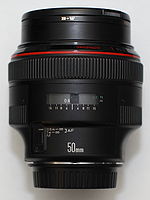 |
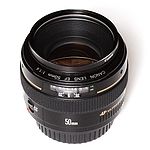 |
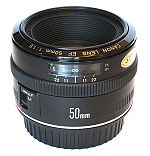 |
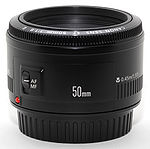 |
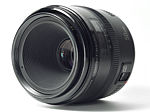 |
|
| Key features | ||||||
| Full-frame compatible |  |
|||||
| Image stabilizer |  |
|||||
| Ultrasonic Motor |  |
 |
||||
| L-series |  |
 |
||||
| Diffractive Optics |  |
|||||
| Macro Macro photography Macrophotography is close-up photography, usually of very small subjects. Classically a macrophotograph is one in which the size of the subject on the negative is greater than life size. However in modern use it refers to a finished photograph of a subject at greater than life size... |
 |
 |
||||
| Technical data | ||||||
| Aperture Aperture In optics, an aperture is a hole or an opening through which light travels. More specifically, the aperture of an optical system is the opening that determines the cone angle of a bundle of rays that come to a focus in the image plane. The aperture determines how collimated the admitted rays are,... (max-min) |
1.0-16 | 1.2-16 | 1.4-22 | 1.8-22 | 1.8-22 | 2.5-32 |
| Construction | 9 groups / 11 elements | 6 groups / 8 elements | 6 groups / 7 elements | 5 groups / 6 elements | 8 groups / 9 elements | |
| # of diaphragm Diaphragm (optics) In optics, a diaphragm is a thin opaque structure with an opening at its center. The role of the diaphragm is to stop the passage of light, except for the light passing through the aperture... blades |
8 | 5 | 6 | |||
| Closest focusing distance | 2ft / 0.6m | 1.5ft / 0.45m | 0.7ft / 0.2m | |||
| Max. magnification | 0.15x (1:6.6) | 0.50x (1:2) | ||||
| Horizontal viewing angle Angle of view In photography, angle of view describes the angular extent of a given scene that is imaged by a camera. It is used interchangeably with the more general term field of view.... |
40° | |||||
| Diagonal viewing angle Angle of view In photography, angle of view describes the angular extent of a given scene that is imaged by a camera. It is used interchangeably with the more general term field of view.... |
46° | |||||
| Vertical viewing angle Angle of view In photography, angle of view describes the angular extent of a given scene that is imaged by a camera. It is used interchangeably with the more general term field of view.... |
27° | |||||
| Physical data | ||||||
| Weight | 2.2lb / 985g | 1.2lb / 545g | 0.6lb / 290g | 0.4lb / 190g | 0.3lb / 130g | 0.6lb / 280g |
| Maximum diameter | 3.6in / 91.5mm | 3.6in / 85.4mm | 2.9in / 73.8mm | 2.6in / 67.4mm | 2.6in / 68.2mm | 2.7in / 67.6mm |
| Length | 3.2in / 81.5mm | 2.6in / 65.5mm | 2.0in / 50.5mm | 1.7in / 42.5mm | 1.6in / 41mm | 2.5in / 63mm |
| Filter diameter | 72mm | 58mm | 52mm | |||
| Accessories | ||||||
| Lens hood | ES-79II | ES-78 | ES-71II | ES-65 | ES-62AD | n/a |
| Previous case | - | ES-C9 | ||||
| Case | LP1216 | LP1214 | LP1014 | LP814 | ||
| Retail information | ||||||
| Release date | September 1989 | August 2006 | June 1993 | March 1987 | December 1990 | December 1987 |
| Currently in production? |  |
 |
 |
 |
||
| MSRP Suggested retail price The manufacturer's suggested retail price , list price or recommended retail price of a product is the price which the manufacturer recommends that the retailer sell the product. The intention was to help to standardise prices among locations... $ United States dollar The United States dollar , also referred to as the American dollar, is the official currency of the United States of America. It is divided into 100 smaller units called cents or pennies.... |
$4210 | $1599 | $520 | $130 | ||
| Street Price $ United States dollar The United States dollar , also referred to as the American dollar, is the official currency of the United States of America. It is divided into 100 smaller units called cents or pennies.... |
$1500 to $2000 | $1599 | $450 | $150-$200 | $140 | $230 |
50mm 1.0L USM
50mm 1.2L USM
50mm 1.4 USM
50mm 1.8 I & II
- Lens Reviews
- DPreview
- photodo (MTF)
- photozone.de
- Comparison between Mark I & II
- SLRgear.com
- The-Digital-Picture (includes comparison of 50mm lenses)
- photo.net

